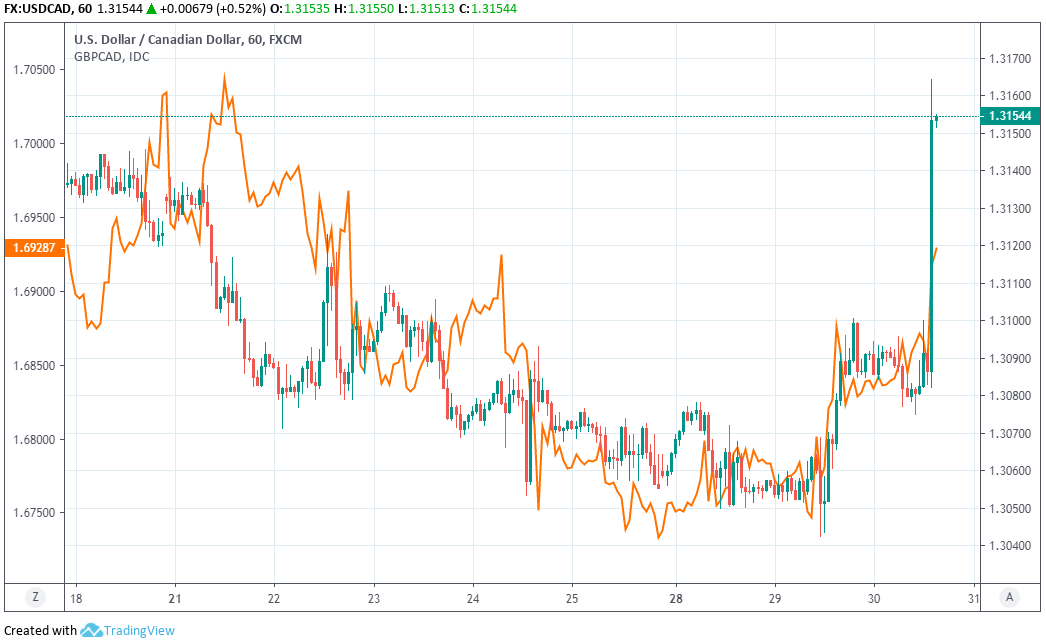The Canadian Dollar Crashes after BoC Signals Interest Rate Cut Ahead
- Written by: James Skinner
-

Image © Bank of Canada, Reproduced Under CC Licensing
- CAD clobbered after BoC hints of a rate cut ahead.
- Holds cash rate at 1.75% but doubts policy settings.
- Abandons claim current policy setting is "appropriate".
- Sends off-guard market scurrying to price in a rate cut.
- CIBC and RBC tip first rate cut to come in early 2020.
The Canadian Dollar slumped against its British and U.S. rivals Wednesday after the Bank of Canada (BoC) surprised an off-guard market by hinting that an interest cut could be imminent given the slowing U.S. and global economies, which pose a risk to Canada's economic and inflation outlooks.
Canada's cash rate was left unchanged at 1.75% on Wednesday, in line with market expectations, but the BoC's commentary on the economy and outlook took a new 'dovish' turn this month. Most notably, the bank has abandoned its oft repeated claim the current level of borrowing costs is "appropriate", and warned instead that the economy's resilience will be "tested" by trade conflicts and uncertainty over the global growth outlook in the months ahead.
The BoC has tipped a slowdown in the second half of the year for a while now, although it's only ever forecast a modest one. It said Wednesday that growth will be "below its potential" in the second half this year due to trade conflicts, goings on in the energy sector and the fading of "temporary factors" that helped buoy the economy to its best performance since early 2017 in the last quarter.
"The door was left ajar for a cut down the road, with the Bank noting the global slowing and saying that the resilience we've seen "will be increasingly tested". There was also a mention to the currency having appreciated against non-USD currencies, perhaps a sign that they are concerned about a further climb," says Avery Shenfeld, chief economist at CIBC Capital Markets. "Overall, a dovish tilt that is consistent with our view that the BoC will cut rates once (in January)."
Other central banks including the Federal Reserve (Fed) across the border have cut rates this year but many of those to have already done so have long fought losing battles against the forces of disinflation, although the U.S. is not only different but also the overseas institution the BoC would be most likely to follow in the footsteps of. The Fed began signalling cuts in January, well before the economy slowed noticeably, and has since cut the Fed Funds rate twice.

Above: USD/CAD rate shown at hourly intervals, alongside Pound-to-Canadian-Dollar rate (orange line, left axis).
The Fed has mostly cited the prospect of a slowing global economy eventually hurting the U.S. as being behind its rate cuts, which could prove an equally powerful motivation for the BoC, which has repeatedly cited "trade tensions" for it having become more cautious about the outlook this year. The BoC has so-far been able to leave its cash rate at a post-crisis high of 1.75% due to outperformance by Canada's economy, which is enjoying a rebound in energy markets and the export trade this year.
"Rising wages and lower interest rates are providing support to the consumer and housing sectors. But falling commodity prices, a strengthening Canadian dollar, and ongoing softness in the energy sector are clearly headwinds. Today’s dovish policy statement boosted market odds of a rate cut in the first half of 2020, and leaves us more comfortable with our call for a move early next year," says Josh Nye, an economist at RBC Capital Markets.
Pricing in the overnight-index-swap market had implied on Wednesday, a BoC cash rate of 1.69% on March 04, which is just six basis points below the current 1.75% level and suggests strongly that investors had been thinking the BoC would be unlikely to cut rates before then. But implied levels of the cash rate at various points up ahead were in decline following Wednesday's statement, taking the Canadian Dollar down with them.
Changes in interest rates are normally only made in response to movements in inflation, which is sensitive to growth, but impact currencies because of the push and pull influence they have over capital flows. Capital flows tend to move in the direction of the most advantageous or improving returns, with a threat of lower rates normally seeing investors driven out of and deterred away from a currency. Rising rates have the opposite effect.
"The reaction from the BoC statement reinforces CAD's vulnerability to some of the key G10 crosses. Some of this stems from positioning, though CAD has also lost some appeal on our MRSI framework. In turn, USDCAD looks en route to 1.33 while NOK, NZD, and AUD look attractive against it on a mix of valuation and a shift of the market narrative," says Mark McCormick, global head of FX strategy at TD Securities.
Above: USD/CAD rate shown at daily intervals, alongside Pound-to-Canadian-Dollar rate (orange line, left axis).
Time to move your money? Get 3-5% more currency than your bank would offer by using the services of a specialist foreign exchange specialist. A payments provider can deliver you an exchange rate closer to the real market rate than your bank would, thereby saving you substantial quantities of currency. Find out more here. * Advertisement
